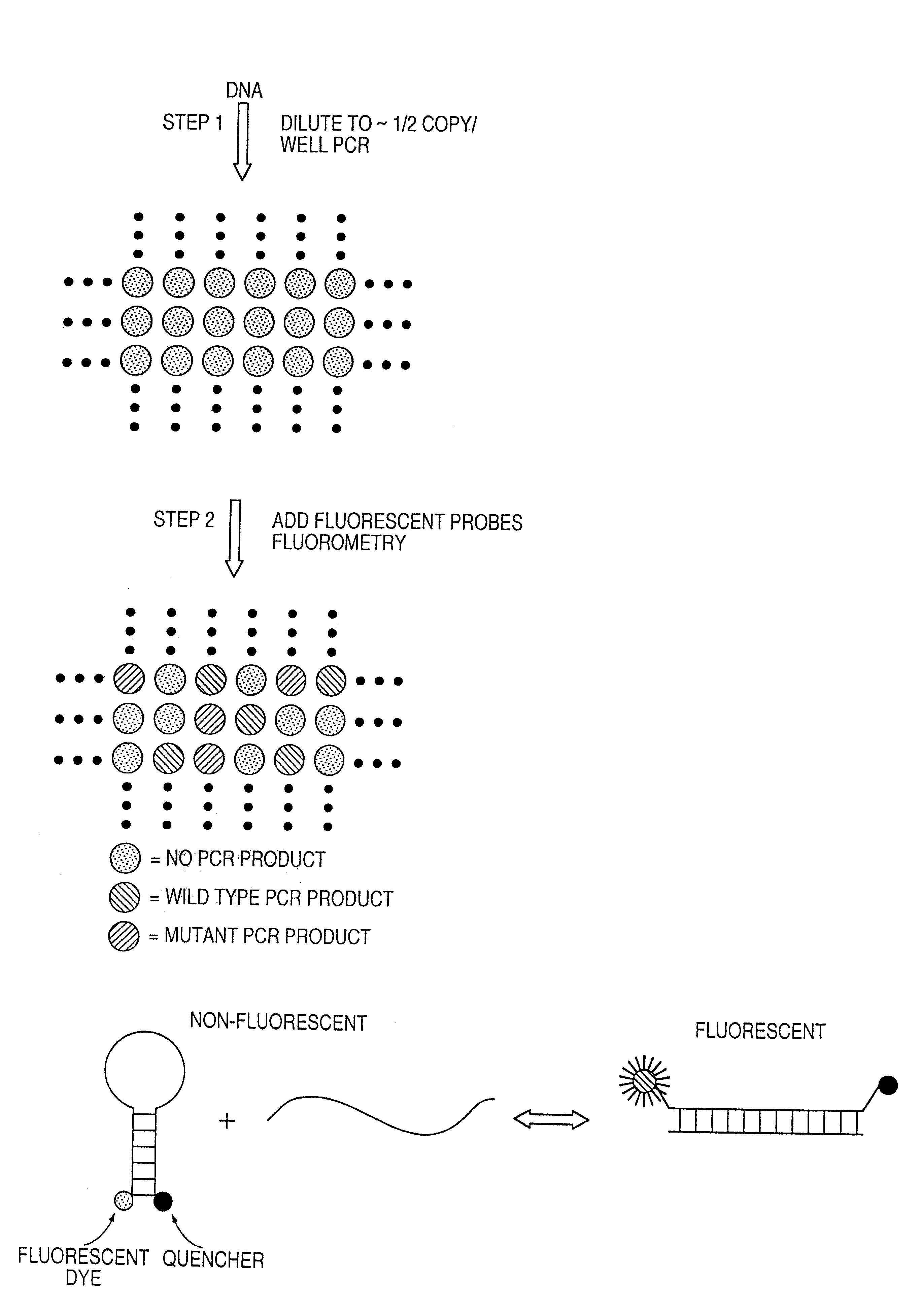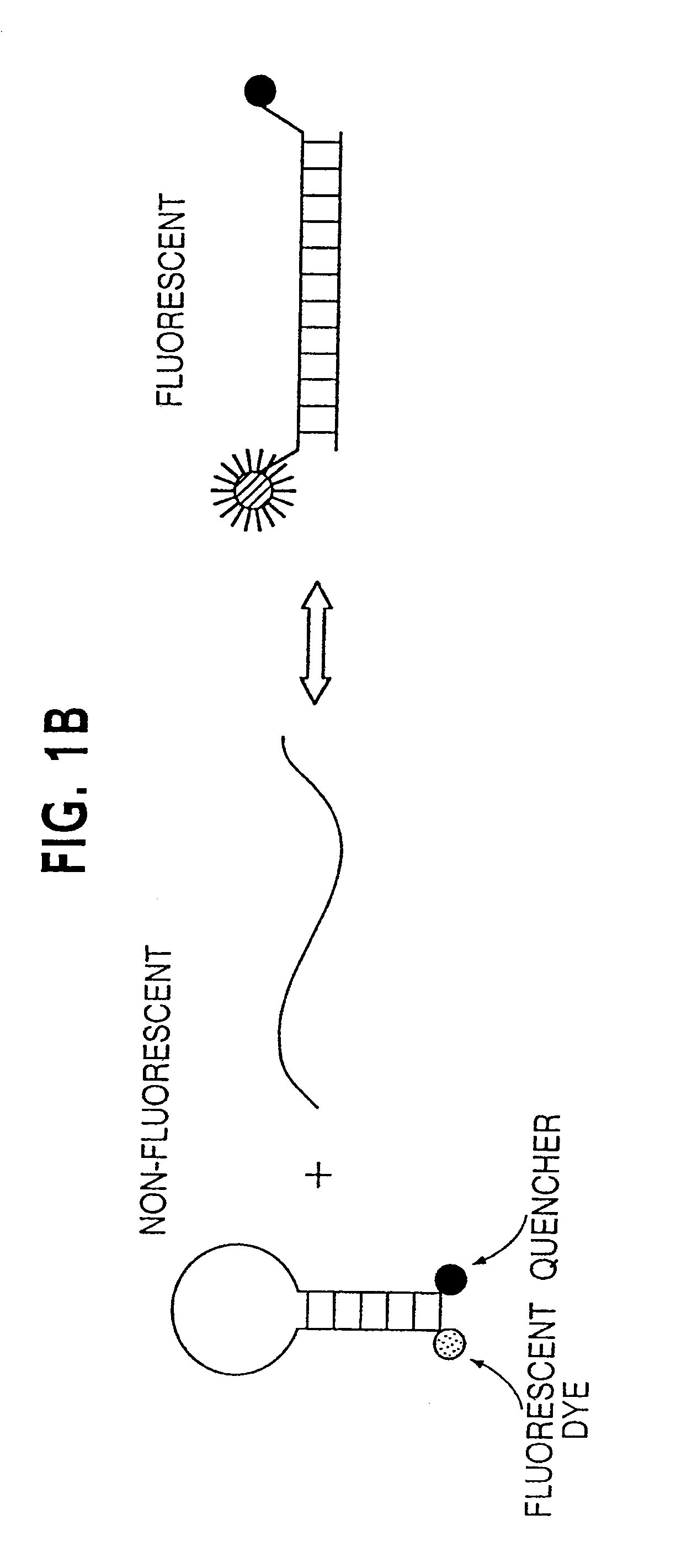Digital amplification
- Summary
- Abstract
- Description
- Claims
- Application Information
AI Technical Summary
Benefits of technology
Problems solved by technology
Method used
Image
Examples
example 1
[0035]Step 1: PCR amplifications. The optimal conditions for PCR described in this section were determined by varying the parameters described in the Results. PCR was performed in 7 ul volumes in 96 well polypropylene PCR plates (RPI). The composition of the reactions was: 67 mM Tris, pH 8.8, 16.6 mM NH4SO4, 6.7 mM MgCl2, 10 mM β-mercaptoethanol, 1 mM dATP, 1 mM dCTP, 1 mM dGTP, 1 mM TTP, 6% DMSO, 1 uM primer F1, 1 uM primer R1, 0.05 units / ul Platinum Taq polymerase (Life Technologies, Inc.), and “one-half genome equivalent” of DNA. To determine the amount of DNA corresponding to one-half genome equivalent, DNA samples were serially diluted and tested via PCR. The amount that yielded amplification products in half the wells, usually ˜1 pg of total DNA, was defined as “one-half genome equivalent” and used in each well of subsequent Digital Amplification experiments. Fifty ul light mineral oil (Sigma M-3516) was added to each well and reactions performed in a HybAid Thermal cycler at ...
example 2
[0036]Step 2: Fluorescence analysis. 3.5 ul of a solution with the following composition was added to each well: 67 mM Tris, pH 8.8, 16.6 mM NH4SO4, 6.7 mM MgCl2, 10 mM β-mercaptoethanol, 1 mM dATP, 1 mM dCTP, 1 mM dGTP, 1 mM TTP, 6% DMSO, 5 uM primer INT, 1 uM MB-GREEN, 1 uM MB-RED, 0.1 units / ul Platinum Taq polymerase. The plates were centrifuged for 20 seconds at 6000 g and fluorescence read at excitation / emission wavelengths of 485 nm / 530 nm for MB-GREEN and 530 nm / 590 nm for MB-RED. This fluorescence in wells without template was typically 10,000 to 20,000 fluorescence “units”, with about 75% emanating from the fluorometer background and the remainder from the MB probes. The plates were then placed in a thermal cycler for asymmetric amplification at the following temperatures: 94° for one minute; 10-15 cycles of 94° for 15 sec, 55° for 15 sec., 70° for 15 seconds; 60° for five minutes. The plates were then incubated at room temperature for at least 20 minutes and fluorescence m...
example 3
[0037]
Oligonucleotides and DNA sequencing.Primer F1:5′-CATGTTCTAATATAGTCACATTTTCA-3′;Primer R1:5′-TCTGAATTAGCTGTATCGTCAAGG-3′;Primer INT:5′-TAGCTGTATCGTCAAGGCAC-3′;MB-RED:5′-Cy3-CACGGGCCTGCTGAAAATGACTGCGTG-Dabcyl-3′;MB-GREEN:5′-Fluorescein-CACGGGAGCTGGTGGCGTAGCGTG-Dabcyl-3′.
[0038]Molecular Beacons were synthesized by Midland Scientific and other oligonucleotides were synthesized by Gene Link. All were dissolved at 50 uM in TE (10 mM Tris, pH 8.0 / 1 mM EDTA) and kept frozen and in the dark until use. PCR products were purified using QIAquick PCR purification kits (Qiagen). In the relevant experiments described in the text, 20% of the product from single wells was used for gel electrophoresis and 40% was used for each sequencing reaction. The primer used for sequencing was 5′-CATTATTTTTATTATAAGGCCTGC-3′. Sequencing was performed using fluorescently-labeled ABI Big Dye terminators and an ABI 377 automated sequencer.
PUM
| Property | Measurement | Unit |
|---|---|---|
| Ratio | aaaaa | aaaaa |
| Biological properties | aaaaa | aaaaa |
| Photoluminescence | aaaaa | aaaaa |
Abstract
Description
Claims
Application Information
 Login to View More
Login to View More - R&D
- Intellectual Property
- Life Sciences
- Materials
- Tech Scout
- Unparalleled Data Quality
- Higher Quality Content
- 60% Fewer Hallucinations
Browse by: Latest US Patents, China's latest patents, Technical Efficacy Thesaurus, Application Domain, Technology Topic, Popular Technical Reports.
© 2025 PatSnap. All rights reserved.Legal|Privacy policy|Modern Slavery Act Transparency Statement|Sitemap|About US| Contact US: help@patsnap.com



